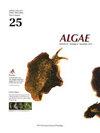在蓝细菌Sphamospermopsis torques reginae ITEP-024中导致分枝杆菌样氨基酸生物合成的冗余途径的遗传和生物化学证据
IF 2.4
3区 生物学
Q1 MARINE & FRESHWATER BIOLOGY
引用次数: 11
摘要
据广泛报道,蓝细菌能产生多种紫外线吸收的类分枝杆菌氨基酸(MAAs)。在此,我们报道了使用新开发的UHPLC-DAD-MS/HRMS(超高效液相色谱-二极管阵列检测-高分辨率串联质谱)方法在蓝细菌Sphaaerospermopsis torques reginae ITEP-024中产生不寻常的MAA,分枝孢子菌甘氨酸丙氨酸(MGA)。MGA先前首次在红藻中被鉴定,但S.torques reginae菌株ITEP-024是第一个被报道为MGA生产者的蓝藻。本文通过一维/二维核磁共振和HRMS数据分析,全面阐明了MGA的化学结构。在ITEP-024的S.torques区域中,MAA异常地组成性产生,并且这种产生在紫外线照射后进一步增强。有人提出,在蓝藻中,MAA的生物合成是从磷酸戊糖途径中间体7-磷酸沙酮糖进行的。对S.torques reginae ITEP-024基因组序列中编码的基因簇的注释支持这些基因产物可以催化MAAs的生物合成。然而,将草甘膦添加到S.torques reginae ITEP-024的培养物中,消除了组成型和紫外线辐射诱导的MGA、shinorine和卟啉-334的产生。这一发现支持了莽草酸途径参与该物种MAAs的生物合成。本文章由计算机程序翻译,如有差异,请以英文原文为准。
Genetic and biochemical evidence for redundant pathways leading to mycosporine-like amino acid biosynthesis in the cyanobacterium Sphaerospermopsis torques-reginae ITEP-024
Cyanobacteria have been widely reported to produce a variety of UV-absorbing mycosporine-like amino acids (MAAs). Herein, we reported production of the unusual MAA, mycosporine-glycine-alanine (MGA) in the cyanobacterium Sphaerospermopsis torques-reginae ITEP-024 using a newly developed UHPLC-DAD-MS/HRMS (ultra-high performance liquid chromatography–diode array detection–high resolution tandem mass spectrometry) method. MGA had previously been first identified in a red-algae, but S. torques-reginae strain ITEP-024 is the first cyanobacteria to be reported as an MGA producer. Herein, the chemical structure of MGA is fully elucidated from one-dimensional / two-dimensional nuclear magnetic resonance and HRMS data analyses. MAAs are unusually produced constitutively in S. torques-reginae ITEP-024, and this production was further enhanced following UV-irradiance. It has been proposed that MAA biosynthesis proceeds in cyanobacteria from the pentose phosphate pathway intermediate sedoheptulose 7-phos-phate. Annotation of a gene cluster encoded in the genome sequence of S. torques-reginae ITEP-024 supports these gene products could catalyse the biosynthesis of MAAs. However, addition of glyphosate to cultures of S. torques-reginae ITEP-024 abolished constitutive and ultra-violet radiation induced production of MGA, shinorine and porphyra-334. This finding supports involvement of the shikimic acid pathway in the biosynthesis of MAAs by this species.
求助全文
通过发布文献求助,成功后即可免费获取论文全文。
去求助
来源期刊

Algae
PLANT SCIENCES-
CiteScore
5.10
自引率
25.00%
发文量
18
期刊介绍:
ALGAE is published by the Korean Society of Phycology and provides prompt publication of original works on phycology. ALGAE publishes articles on all aspects of phylogenetics and taxonomy, ecology and population biology, physiology and biochemistry, cell and molecular biology, and biotechnology and applied phycology. Checklists or equivalent manu-scripts may be considered for publication only if they contribute original information on taxonomy (e.g., new combinations), ecology or biogeography of more than just local relevance. Contributions may take the form of Original Research Articles, Research Notes, Review Articles and Book Reviews.
 求助内容:
求助内容: 应助结果提醒方式:
应助结果提醒方式:


